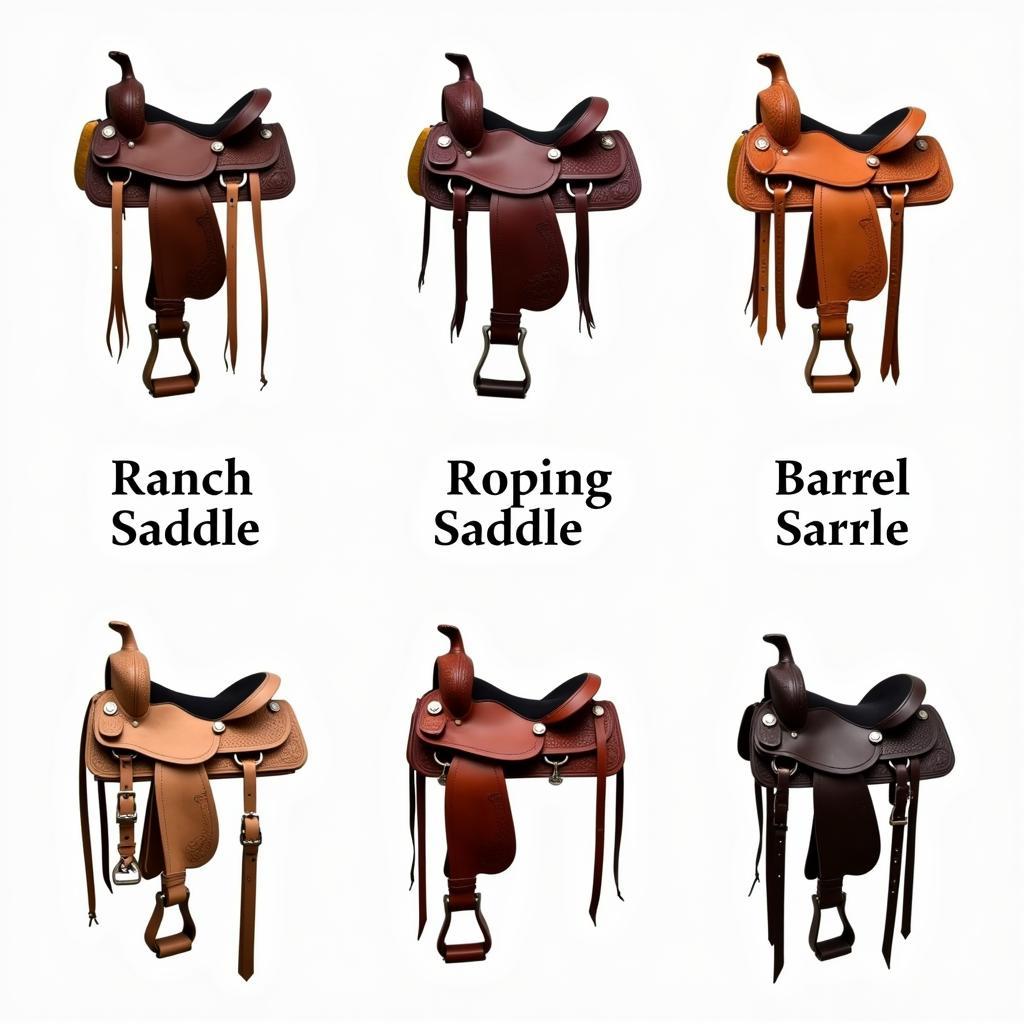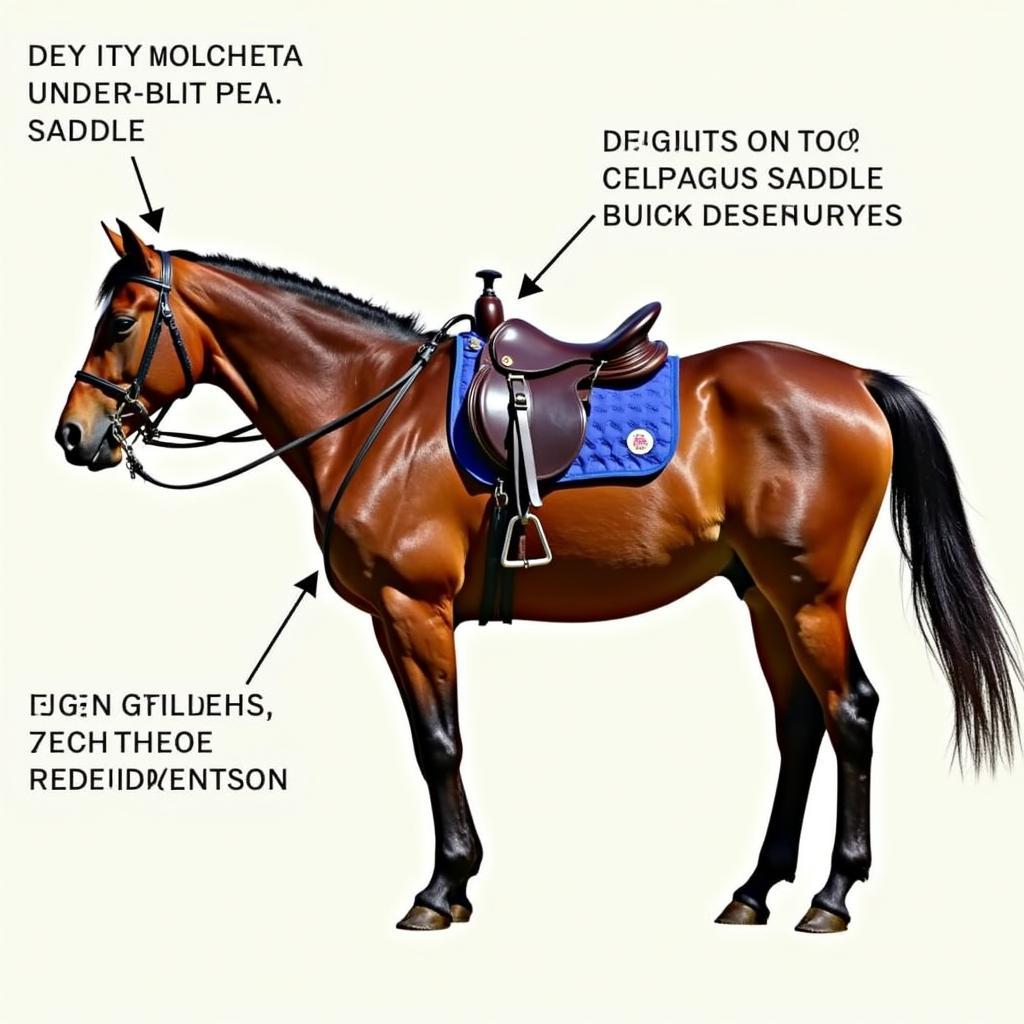A Horse Western Saddle is more than just a seat for the rider; it’s a crucial piece of equipment designed to provide comfort and support for both horse and rider during long hours of work or riding. With a rich history and evolution rooted in the ranching lifestyle of the American West, western saddles are renowned for their durability, functionality, and iconic aesthetics. Whether you’re a seasoned rancher or a weekend trail rider, selecting the right western saddle can significantly impact your riding experience and your horse’s well-being.
 Different types of western saddles.
Different types of western saddles.
Understanding the Western Saddle
Before delving into the intricacies of choosing a horse western saddle, it’s essential to grasp the fundamental components that make up this iconic saddle type. Unlike its English counterparts, the western saddle features a heavier build and a larger seat designed for extended riding sessions.
Key Features of a Western Saddle
Here’s a closer look at the defining parts of a horse western saddle:
- Horn: The most recognizable feature of a western saddle, the horn, is a sturdy, often wrapped, protrusion at the front. Initially designed for anchoring a lasso, today, it primarily serves as a handle for balance and stability.
- Seat: The rider’s seat is typically deep and spacious, offering a comfortable riding experience, especially during long rides.
- Cantle: This is the raised back of the saddle, providing additional support and preventing the rider from being thrown backward.
- Stirrups: Designed for comfort and functionality, western stirrups are wider and often covered with leather, offering better support and protecting the rider’s feet.
- Skirts: The leather panels extending from the seat down the horse’s sides are called skirts. They play a vital role in distributing the rider’s weight evenly across the horse’s back.
- Fenders: Attached to the stirrup leathers, fenders offer leg protection and can be adjusted for rider comfort and leg length.
Factors to Consider When Choosing a Western Saddle
Selecting the perfect western saddle is a significant decision, influenced by various factors. Here’s a comprehensive guide to navigate the selection process:
1. Horse’s Conformation and Back Shape
Every horse has a unique back shape and conformation. It’s crucial to choose a saddle that complements your horse’s physique to ensure a proper fit and prevent discomfort or injury.
- High Withers: Horses with prominent withers require saddles with a narrower gullet (the space between the bars that sits over the horse’s withers) and a higher pommel (the front of the saddle).
- Low Withers: For horses with lower or flatter withers, a saddle with a wider gullet and a rounded skirt shape is ideal.
“When choosing a saddle for a horse with high withers, it’s crucial to ensure adequate clearance to prevent pressure points and discomfort,” advises Sarah Jenkins, a certified equine saddle fitter.
2. Riding Discipline and Purpose
The type of riding you plan to do plays a crucial role in determining the most suitable saddle type.
- Trail Riding: For leisurely trail rides, saddles with comfortable seats, deep stirrups, and ample padding are ideal.
- Ranch Work: Ranchers need durable saddles with a deep seat, a tall horn for dallying ropes, and a design that allows for freedom of movement.
- Barrel Racing: Lightweight saddles with a high cantle and close contact design are preferred for barrel racing to allow for quick turns and agility.
 A side view of a western saddle on a horse, illustrating proper saddle fit.
A side view of a western saddle on a horse, illustrating proper saddle fit.
3. Saddle Fit for the Rider
A well-fitting saddle is as crucial for the rider as it is for the horse.
- Seat Size: The rider’s size and leg length determine the appropriate seat size. A saddle that is too small will be uncomfortable, while one that’s too large will lack stability.
- Stirrup Length: Proper stirrup length ensures a balanced riding position and prevents strain on the rider’s legs.
4. Saddle Materials and Construction
Western saddles are typically crafted from leather, known for its durability and ability to mold to the horse’s shape over time.
- Leather Quality: Look for saddles made from high-quality, full-grain leather that can withstand wear and tear.
- Tree Material: The saddle tree is the internal framework that determines its shape and strength. Trees are typically made of wood, fiberglass, or a combination of materials.
5. Budget
Western saddles can range in price from a few hundred dollars to several thousand. Setting a budget beforehand can help narrow down your options and prioritize your needs.
Caring for Your Western Saddle
Investing in a high-quality horse western saddle is a significant step, and proper care is essential for preserving its longevity and ensuring its optimal performance.
Cleaning and Conditioning
- Regularly clean your saddle using a damp cloth and saddle soap to remove dirt, sweat, and debris.
- Apply a leather conditioner to keep the leather supple and prevent cracking.
Storage
- Store your saddle in a cool, dry place, away from direct sunlight or heat sources.
- Use a saddle rack or stand to maintain its shape and prevent damage.
Conclusion
Choosing the perfect horse western saddle is a blend of understanding your horse’s needs, your riding style, and the demands of your chosen discipline. By carefully considering these factors and investing in a well-crafted saddle, you can enhance your riding experience and forge a deeper connection with your equine partner. Remember, a well-fitting and comfortable saddle is an investment in both your horse’s well-being and your enjoyment of countless hours in the saddle.
For guidance on selecting the perfect saddle for you and your horse, explore our range of high-quality western saddles or reach out to our expert team for personalized assistance. We’re here to help you find the ideal saddle to embark on your next equestrian adventure.
FAQ
What is the difference between a western saddle and an English saddle?
Western saddles are larger and heavier than English saddles, with a deep seat, a horn, and a higher cantle. They are designed for comfort and stability during long rides and ranch work. English saddles are lighter and smaller, with a flatter seat and no horn. They are designed for more precise control and communication with the horse, often used in disciplines like dressage and jumping.
How do I know if a western saddle fits my horse correctly?
A properly fitted western saddle should have adequate gullet clearance, distribute weight evenly across the horse’s back, and sit comfortably behind the shoulder blades without hindering movement. It’s always recommended to consult with a qualified saddle fitter for professional assessment and adjustments.
How often should I clean my western saddle?
It’s a good practice to clean your saddle after each ride to remove sweat and dirt. A more thorough cleaning with saddle soap and conditioner can be done weekly or bi-weekly, depending on usage.
Can I use a western saddle for English riding disciplines?
While you can technically sit in a western saddle and cue a horse as you would in an English saddle, it’s not recommended. Western saddles are designed for a different riding style and can interfere with the horse’s movement and the rider’s communication in English disciplines.
What is the average lifespan of a well-maintained western saddle?
A high-quality western saddle, with proper care and maintenance, can last for many years, even decades. Regular cleaning, conditioning, and proper storage are crucial for extending its lifespan.
What are some common mistakes to avoid when choosing a western saddle?
Some common mistakes include: choosing a saddle based solely on aesthetics, neglecting to consider the horse’s conformation, not getting a professional saddle fitting, and opting for a cheaper saddle without considering quality and durability.
Where can I find more information about western saddles?
For more insights and guidance on selecting the right western saddle, explore our informative articles on breyer horse western saddle, western horse riding lessons near me, and western horse saddle pad. Our comprehensive resources provide valuable information on various aspects of western saddles and equestrian care.
Need assistance with finding the perfect western saddle or other horse-related products? Contact our team at Justus Horses USA. Call us at 0772127271, email us at [email protected], or visit our location at QGM2+WX2, Vị Trung, Vị Thuỷ, Hậu Giang, Vietnam. Our dedicated customer support team is available 24/7 to help you with all your equestrian needs.